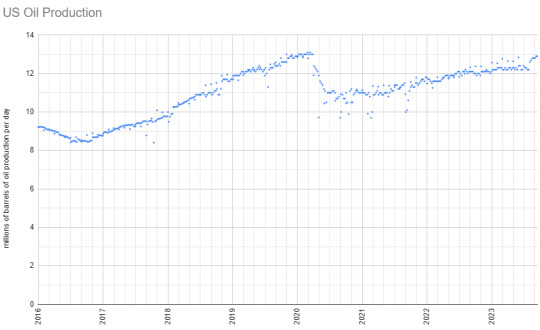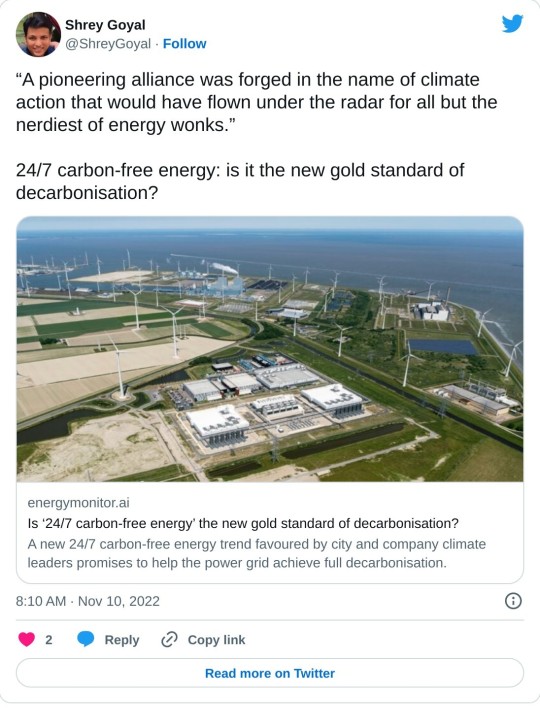#Energy Policy
Text
It would, of course, have made more sense to stop suppressing domestic oil drilling, but Dementia Joe has no sense. We’re now down to an 18 day supply in the Strategic Petroleum Reserve. Absolute idiocy!
#leadership#joe biden#dementia joe#oil#oil and gas#oil drilling#energy policy#energy independence#energy security
5 notes
·
View notes
Text


These charts are based on data from the Energy Information Agency (EIA), the government agency that the oil and gas industry relies on to provide accurate measures of US and international energy production, imports, exports, and other data.
The EIA provides US oil production data compiled monthly since 1920 or compiled weekly since 1983. Both data sets are included in the above charts.
So, in summary, US oil production grew sharply starting in 2011, peaked and began to fall in 2015, bottomed out and started to recover by Oct 2016, recovered by 2018, reached an all-time peak by Feb 2020, then crashed again until Jun 2020, and has recovered ever since back to nearly the all-time peak once again.
For those that love to assign the US President all credit for oil production, there are serious upturns under Obama (2011-2016), Trump (2017-2019), and Biden (2021-present) and serious downturns under Obama (2015-6) and Trump (2020). Make of that what you will.
#data#oil and gas#oil production#usa#us politics#uspol#american politics#energy policy#crude oil#oil prices
2 notes
·
View notes
Text

View on Twitter
“A pioneering alliance was forged in the name of climate action that would have flown under the radar for all but the nerdiest of energy wonks.”
24/7 carbon-free energy: is it the new gold standard of decarbonisation?
https://t.co/245T4B9uvK
(Source)
#Climate Change#clean energy#energy crisis#energy policy#Climate Crisis#Late Stage Capitalism#My Tweets
2 notes
·
View notes
Quote
China is leading the way on renewable energy and moving away from fossil fuel dependence, said Buckley, who tracks the country’s energy policy. “It might be because they are paranoid about climate change or because they want to absolutely dominate industries of the future. At the end of the day, the reason doesn’t really matter.” India is also investing heavily in renewable energy and has committed to producing 50% of its power from clean energy sources by 2030. “The invasion has made India rethink its energy security concerns,” said Swati D’Souza, of the Institute for Energy Economics and Financial Analysis.
‘What the war in Ukraine means for Asia’s climate goals’, Associated Press
#Associated Press#China#renewable energy#fossil fuel dependence#Tim Buckley#energy policy#climate change#India#clean energy sources#2022 Russian invasion of Ukraine#Swati D’Souza#Institute for Energy Economics and Financial Analysis#energy security
2 notes
·
View notes
Text
How Can a 6,000 MW Regional Utility in 2030 which Likely Will Be a 9,000 MW Utility in 2050... Achieve Net Zero Carbon? An Update on my Electricity Provider in South Carolina
This is a repost. My great conservative state of South Carolina appears to be heading down the same destructive Net-Zero Carbon path as CA and NY. Here are my thoughts, much of which I have written to my elected representatives and I do appreciate
The Great State of South Carolina is usually thought of as a “Conservative” state. However, when it comes to applying destructive “Climate Policies”, South Carolina is no more conservative than is California or New York. So, I thought I would repost my comments on the Santee-Cooper IRP.
It is my understanding that the major Utilities providing electricity to S.C. (Dominion Energy and…

View On WordPress
0 notes
Text
Over 20% of the world’s refining capacity under threat
More than 20 per cent of the world’s refining capacity is at risk of closure, energy consultancy Wood Mackenzie has found in an analysis released on Thursday, as gasoline profitability declines and pressure to cut carbon dioxide emissions intensifies, according to Reuters.
The company analysed 465 refining assets. Europe and China have the largest number of facilities with high closure risk, jeopardising about 3.9 million barrels per day of refining capacity, according to Wood Mac. The analysis is based on an assessment of net cash margins, cost of carbon emissions, ownership, environmental investment and strategic value of refineries.
The report reveals that there are 11 sites in Europe that account for 45 per cent of all high-risk facilities. According to industry organisation Concawe, some 30 European refineries have already closed since 2009, with almost 90 still operating.
The tide of closures was driven by competition from new and more sophisticated businesses in the Middle East and Asia, as well as the impact of the COVID-19 pandemic.
Read more HERE

#world news#world politics#news#global news#global market#world events#economy#energy#energy work#energy update#energy production#energy prices#energy policy#refined#refinery
0 notes
Text
Argentina & Chile: A Tale of Two Countries - CleanTechnica
0 notes
Text

Biden faces a crucial fossil fuel decision. Will he stand up to Big Oil?
Washington is too fixated on either/or when their object should be safe, economically-stable transition.
1 note
·
View note
Text
How the Last Drops of Oil Will Reshape Our World
Unveiling the hidden truth: Our world is on the brink of a major shift as we near the last drops of oil. Discover how this will reshape us.
In a world that is becoming increasingly concerned with environmental issues and adopting ‘green’ initiatives, an urgent and transformative change is ACTUALLY happening faster than any panic about global climate cataclysms – the shrinking availability of oil. This change is not driven solely by a heightened awareness of environmental concerns but by the stark reality of our oil reserves depleting…

View On WordPress
#climate change#economic transformation#Energy Crisis#energy policy#energy transition#environmental impact#fossil fuels#future energy#geopolitical stability#global economy#global warming#green initiatives#oil consumption#oil depletion#peak oil#renewable energy#resource scarcity#Sustainability#sustainable living
1 note
·
View note
Text
Pass legislation to significantly expand transmission for clean energy NOW!
AN OPEN LETTER to THE PRESIDENT & U.S. CONGRESS
820 so far! Help us get to 1,000 signers!
Right now, there are at least 2,000 gigawatts of renewable energy waiting for permission to connect to power lines in the U.S., which is more than the total capacity of the country’s existing power plants. Wait times to connect new power plants to the grid can reach five years or more. Without rapidly improving transmission, the United States will not be able to achieve Biden's goal of 100% clean energy by 2035 or provide cheaper, more reliable electricity to American households. If the U.S. can’t build new transmission at a faster pace, roughly 80 percent of the emissions reductions expected from the Inflation Reduction Act–the largest climate legislation in U.S. history–might not happen.
That’s why I’m writing to urge Congress to pass legislation to significantly expand transmission for clean energy.
Multiple efforts are currently in play. Most recently in the House, Representatives Sean Casten and Mike Levin introduced the Clean Energy and Transmission Acceleration Act, (HR 6747) which would encourage the development of new transmission lines to carry renewable power where it’s needed while protecting the rights of communities to provide input on where lines are built and to benefit from their construction. I strongly support this bill.
But any legislation is better than none, and NONE of the bills proposed so far have been passed. This is not good.
Increasing access to clean energy will help tackle the climate crisis by ensuring the reliability of the grid and reducing consumers' bills. Renewable energies like wind and solar are quickly becoming the least expensive source of energy and we need to make sure as many people as possible get access to these clean, abundant energy sources.
Please pass a strong, fair transmission bill—like HR 6747—that prioritizes clean energy, climate change, and environmental justice. This is urgent; all of our children are counting on us to secure their futures. Thanks.
▶ Created on April 23 by Jess Craven · 819 signers in the past 7 days
📱 Text SIGN PMNVSR to 50409
🤯 Liked it? Text FOLLOW JESSCRAVEN101 to 50409
#JESSCRAVEN101#PMNVSR#resistbot#Clean Energy#Renewable Energy#Climate Action#Transmission Expansion#Green Energy#Clean Energy Now#Climate Change#Energy Infrastructure#Renewables#Climate Crisis#Energy Policy#Infrastructure Bill#Green Grid#Renewable Power#Energy Transition#Climate Legislation#Sustainable Energy#Clean Tech#Electric Grid#Energy Security#Energy Equity#Renewable Future#Grid Modernization#Climate Justice#Energy Innovation#Renewable Resources#Energy Efficiency
0 notes
Text
I guess the Bidenistas have finally realized that draining the Strategic Petroleum Reserve and relying on nations like Iran, Venezuela, and Saudi Arabia for oil is an idiotic and dangerous energy policy. I suppose even slow learners can eventually learn.
#biden administration#energy#energy crisis#energy policy#energy security#energy independence#oil#oil and gas
10 notes
·
View notes
Text
Energy Transition or Energy Diversification? Assessing the Complexity of the Energy Ecosystem
A recently published article discusses the issue of the recent shift in the global energy paradigm due to response of governments to pandemics and conflicts in the context of complexity. The abstract of the article is cited below while the whole article is available here:
“The recent shift in the global energy paradigm and the expansion of renewable energy, spurred by the global COVID-19…

View On WordPress
#Complexity#complexity management#economy#energy#energy landscape#energy policy#Extreme problems#Giuseppe Graci#Ontonix#resilience
0 notes
Text
Advance Energy Storage Market Research Report Includes Dynamics Demands, Products, Types and Application 2017 – 2032

Overview of the Market:
providing efficient and reliable storage solutions for electricity generated from renewable and conventional sources. These storage systems enable the balancing of supply and demand, integration of intermittent renewable energy, grid stabilization, and optimization of energy usage. The global advanced energy storage systems market is expected to grow at a CAGR of 9% from 2023 to 2032.
Promising Growth and Demand: The advanced energy storage market has experienced significant growth in recent years, driven by several factors. Increasing renewable energy deployment, declining costs of storage technologies, and supportive government policies promoting clean energy and grid modernization have spurred the demand for advanced energy storage solutions. Additionally, the need for energy resilience, demand management, and peak shaving in industries, commercial buildings, and residential applications has further contributed to market growth.
Platform Type: The advanced energy storage market encompasses various platform types for energy storage:
Battery Energy Storage Systems (BESS): Battery-based energy storage systems are one of the most widely used platforms. They employ rechargeable batteries, such as lithium-ion, lead-acid, or flow batteries, to store and discharge electricity as needed.
Pumped Hydro Storage: Pumped hydro storage utilizes the gravitational potential energy of water by pumping it to a higher elevation during times of excess electricity and releasing it through turbines to generate electricity during peak demand periods.
Thermal Energy Storage: Thermal energy storage systems store and release thermal energy using materials such as molten salts or phase change materials. This technology is often utilized for heating, cooling, and industrial processes.
Flywheel Energy Storage: Flywheel systems store rotational energy in a spinning flywheel, which can be converted back into electricity when needed. They provide high-speed, short-duration energy storage.
Technology: Advanced energy storage systems employ various technologies to store and deliver electricity efficiently:
Lithium-ion Batteries: Lithium-ion batteries are the most common technology used in battery energy storage systems. They offer high energy density, long cycle life, and rapid response times.
Flow Batteries: Flow batteries use electrolyte solutions stored in external tanks to store and release energy. They offer scalability and long cycle life, making them suitable for large-scale applications.
Compressed Air Energy Storage (CAES): CAES systems compress air and store it in underground caverns or tanks. The stored air is then expanded through turbines to generate electricity during peak demand.
Thermal Storage Technologies: Thermal energy storage systems utilize materials with high specific heat capacity or phase change materials to store thermal energy for later use in heating or cooling applications.
End User Industry: The advanced energy storage market serves various end user industries, including:
Utilities and Grid Operators: Utilities and grid operators utilize advanced energy storage systems to optimize grid stability, manage peak demand, integrate renewable energy, and enhance grid resilience.
Commercial and Industrial Sectors: Commercial and industrial facilities deploy energy storage solutions to manage electricity costs, reduce peak demand charges, provide backup power, and optimize on-site renewable energy generation.
Residential Sector: Residential applications of advanced energy storage include residential solar systems with battery storage for self-consumption, backup power during outages, and demand management.
Scope:
The advanced energy storage market has a global scope, with increasing deployment in various regions. The market encompasses equipment manufacturers, system integrators, energy storage developers, and utilities. Market statistics, growth projections, and demand may vary across regions due to factors such as energy policies, market maturity, and renewable energy penetration.
The market's scope extends to various aspects, including technology advancements, cost reduction, grid integration, and energy management solutions. With the increasing need for clean energy, grid stability, and energy efficiency, the demand for advanced energy storage solutions is expected to grow, presenting opportunities for industry players.
In conclusion, the advanced energy storage market is experiencing promising growth globally. The adoption of advanced energy storage systems is driven by factors such as renewable energy integration, grid modernization, and the need for energy management and resilience. The market serves utilities, commercial, industrial, and residential sectors, utilizing technologies such as batteries, pumped hydro, thermal storage, and flywheels. As the world transitions towards a more sustainable energy future, the demand for advanced energy storage solutions is expected to increase, providing significant opportunities for industry participants in the global energy sector.
We recommend referring our Stringent datalytics firm, industry publications, and websites that specialize in providing market reports. These sources often offer comprehensive analysis, market trends, growth forecasts, competitive landscape, and other valuable insights into this market.
By visiting our website or contacting us directly, you can explore the availability of specific reports related to this market. These reports often require a purchase or subscription, but we provide comprehensive and in-depth information that can be valuable for businesses, investors, and individuals interested in this market.
“Remember to look for recent reports to ensure you have the most current and relevant information.”
Click Here, To Get Free Sample Report: https://stringentdatalytics.com/sample-request/solar-panel-recycling-management-market/11372/
Market Segmentations:
Global Solar Panel Recycling Management Market: By Company
• First Solar
• Envaris
• REMA PV Systems
• Darfon Electronics
• Rinovasol
• Chaoqiang Silicon Material
• Suzhou Shangyunda Electronics
• PV Recycling
• Silcontel
• Cellnex Energy
• IG Solar Private
Global Solar Panel Recycling Management Market: By Type
• Monocrystalline cells
• Polycrystalline cells
Global Solar Panel Recycling Management Market: By Application
• Industrial
• Commercial
• Utility
• Others
Global Solar Panel Recycling Management Market: Regional Analysis
The regional analysis of the global Solar Panel Recycling Management market provides insights into the market's performance across different regions of the world. The analysis is based on recent and future trends and includes market forecast for the prediction period. The countries covered in the regional analysis of the Solar Panel Recycling Management market report are as follows:
North America: The North America region includes the U.S., Canada, and Mexico. The U.S. is the largest market for Solar Panel Recycling Management in this region, followed by Canada and Mexico. The market growth in this region is primarily driven by the presence of key market players and the increasing demand for the product.
Europe: The Europe region includes Germany, France, U.K., Russia, Italy, Spain, Turkey, Netherlands, Switzerland, Belgium, and Rest of Europe. Germany is the largest market for Solar Panel Recycling Management in this region, followed by the U.K. and France. The market growth in this region is driven by the increasing demand for the product in the automotive and aerospace sectors.
Asia-Pacific: The Asia-Pacific region includes Singapore, Malaysia, Australia, Thailand, Indonesia, Philippines, China, Japan, India, South Korea, and Rest of Asia-Pacific. China is the largest market for Solar Panel Recycling Management in this region, followed by Japan and India. The market growth in this region is driven by the increasing adoption of the product in various end-use industries, such as automotive, aerospace, and construction.
Middle East and Africa: The Middle East and Africa region includes Saudi Arabia, U.A.E, South Africa, Egypt, Israel, and Rest of Middle East and Africa. The market growth in this region is driven by the increasing demand for the product in the aerospace and defense sectors.
South America: The South America region includes Argentina, Brazil, and Rest of South America. Brazil is the largest market for Solar Panel Recycling Management in this region, followed by Argentina. The market growth in this region is primarily driven by the increasing demand for the product in the automotive sector.
Visit Report Page for More Details: https://stringentdatalytics.com/reports/solar-panel-recycling-management-market/11372/
Reasons to Purchase Solar Panel Recycling Management Market Report:
Informed Decision-Making: A comprehensive market research report provides valuable insights and analysis of the district heating market, including market size, growth trends, competitive landscape, and key drivers and challenges. This information allows businesses to make informed decisions regarding investments, expansion strategies, and product development.
Market Understanding: Research reports offer a deep understanding of the district heating market, including its current state and future prospects. They provide an overview of market dynamics, such as industry trends, regulatory frameworks, and technological advancements, helping businesses identify opportunities and potential risks.
Competitive Analysis: Market research reports often include a competitive analysis, profiling key players in the district heating market. This analysis helps businesses understand their competitors' strategies, market share, and product offerings. It enables companies to benchmark themselves against industry leaders and identify areas for improvement or differentiation.
Market Entry and Expansion: For companies planning to enter the district heating market or expand their existing operations, a market research report provides crucial information about market saturation, customer preferences, and regional dynamics. It helps businesses identify viable market segments, target demographics, and potential growth areas.
Investment Opportunities: Market research reports highlight investment opportunities in the district heating market, such as emerging technologies, untapped regions, or niche markets. This information can assist investors in making informed decisions about capital allocation and portfolio diversification.
Risk Mitigation: By analyzing market trends, customer preferences, and regulatory frameworks, market research reports help businesses identify and mitigate potential risks and challenges. This proactive approach can minimize uncertainties and optimize decision-making processes.
Cost Savings: Investing in a market research report can potentially save businesses time and resources. Rather than conducting extensive primary research or relying on fragmented information sources, a comprehensive report consolidates relevant data, analysis, and insights in one place, making it a cost-effective solution.
Industry Benchmarking: Market research reports provide benchmarks and performance indicators that allow businesses to compare their performance with industry standards. This evaluation helps companies identify areas where they excel or lag behind, facilitating strategic improvements and enhancing their competitive position.
Long-Term Planning: A global market research report offers a forward-looking perspective on the district heating market, including growth projections, emerging trends, and future opportunities. This insight aids businesses in long-term planning, resource allocation, and adapting their strategies to changing market dynamics.
Credibility and Authority: Market research reports are typically prepared by industry experts, analysts, and research firms with in-depth knowledge of the subject matter. Purchasing a reputable report ensures access to reliable and credible information, enhancing decision-making processes and providing confidence to stakeholders.
In general, market research studies offer companies and organisations useful data that can aid in making decisions and maintaining competitiveness in their industry. They can offer a strong basis for decision-making, strategy formulation, and company planning.
About US:
Stringent Datalytics offers both custom and syndicated market research reports. Custom market research reports are tailored to a specific client's needs and requirements. These reports provide unique insights into a particular industry or market segment and can help businesses make informed decisions about their strategies and operations.
Syndicated market research reports, on the other hand, are pre-existing reports that are available for purchase by multiple clients. These reports are often produced on a regular basis, such as annually or quarterly, and cover a broad range of industries and market segments. Syndicated reports provide clients with insights into industry trends, market sizes, and competitive landscapes. By offering both custom and syndicated reports, Stringent Datalytics can provide clients with a range of market research solutions that can be customized to their specific needs
Contact US:
Stringent Datalytics
Contact No - +1 346 666 6655
Email Id - [email protected]
Web - https://stringentdatalytics.com/
#Advance Energy Storage Market#Renewable Energy#Battery Technology#Grid Integration#Energy Storage Systems#Lithium-ion Batteries#Energy Management#Sustainable Power#Energy Transition#Smart Grid#Electric Vehicles#Power Electronics#Distributed Energy Resources#Energy Efficiency#Carbon Emissions#Grid Stability#Solar Energy#Wind Energy#Energy Policy#Energy Storage Capacity#Energy Infrastructure#Energy Market Trends#Energy Storage Solutions#Microgrids#Demand Response#Energy Storage Technologies#Energy Storage Applications#Energy Storage Investment#Energy Storage Economics#Energy Storage Challenges
0 notes
Text
New America Foundation: Mark Schmitt: Liberal Brain Freeze & Security Narcissists
Source:The New Democrat
I disagree with this blog from the New America Foundation the author of it Mark Schmitt. Liberal Democrats have a clear agenda and clear proposals coming from President Obama who is a Liberal Democrat, at least on economic policy, even though he comes up short when it comes to civil liberties and the War on Drugs. But President Obama has clear liberal leanings when it…

View On WordPress
#2013#America#American Economy#Center Right#Classical Liberalism#Classical Liberals#Democrats#Economic Freedom#Economic Growth#Education#Energy Policy#Immigration Reform#Infrastructure#Job Growth#Job Training#Liberal Democrats#Liberalism#Liberals#Mark Schmitt#Middle Class#New Democrats#United States
0 notes
Text
Giant Sucking Sound
Introduction
The title is from a comment by Ross Perot, Presidential candidate in the 1992 election cycle. Perot was describing what NAFTA would mean for jobs in the U.S.A. if Bill Clinton was elected President and he proceeded with the North American Free Trade Agreement. That was 1992. Ten years later China had been admitted to the World Trade Organization and began its rapid economic growth.…

View On WordPress
0 notes